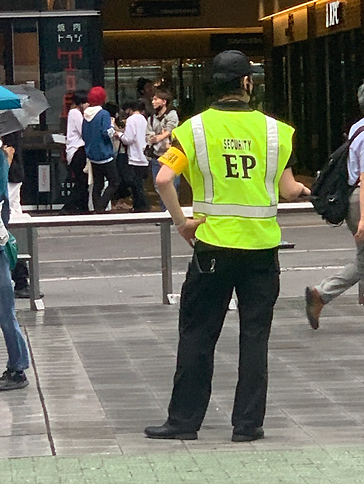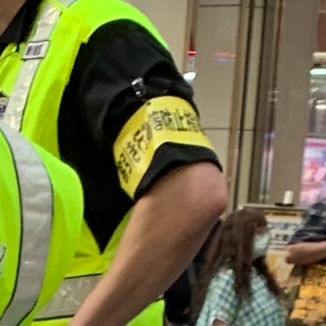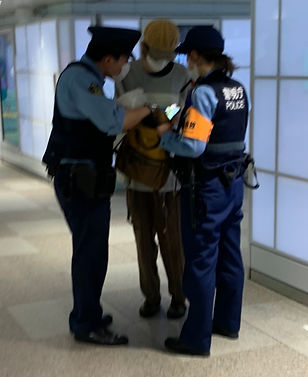
Security Guards
Uniform
by Amelie
Although there seems to be two groups of security guards in the area, both of the security guards have similar characteristics on their uniform and appearances. Uniforms play a significant role in people’s mind, both to the people wearing it and to the observers. For the people wearing it, it provides a sense of belonging and responsibility. As for the observers, it is an essential tool to identify what type of people they are. Johnson states, “Individuals seek clues about others from their appearance. Clothing provides one powerful clue to an individual's background' and serves as a mental shortcut to identify a person's sex, status, group membership, legitimacy, authority, and occupation.”, which emphasize the significance of uniforms even more (Johnson, 2001). Each uniform would represent a group, an organization, an institution, etc., meaning that the uniforms would have their logo or name on it. Just like McDonalds workers wearing a hat with the yellow M mark on it, or the police having a badge on his chest, the security guards in Kabukicho also have a uniform unique to them.
To list accordingly, the security guards in this area wears an all black uniform: black shirt, black cargo pants, black mask, black cap, black leather shoes, and black gloves to name a few. According to a webpage about color psychology, black symbolizes:
“power, elegance, sophistication, status, formality. Evil, death, grief, mourning, the occult. Mystery, bleakness, heaviness, depression, rebellion, fear” (Johnson, N.D.).
Although the occult part may not apply to the security guards, the others could apply to how they want to represent themselves. In order to maintain ordinance in the area, these people must look tough and somewhat intimidating so that people can’t mock them or question them. Thus, the black outfit reflects their rightfulness and power given by the city of Shinjuku. The cargo pants, in fact, is a good example as a tool to boost their authority since this type of pants originated as a Battle Dress Uniform in the UK military (Sisco, 2021). This history along with the rise of cargo pants in fashion in the 1990s by hip-hop artists granted the pants a masculine and professional image.

The uniform of a security person in Kabukicho.
The neon yellow vest is another feature that they have in common. Depending on the group of security, the wording on the back is different. The group hired by Shinjuku city says, “SHINJUKU CITY SAFETY AND SECURITY PATROL”, with safety and security in bigger fonts. Whereas the security hired by the Kumiai writes “SECURITY EP” on the back. Although these are the difference for the neon yellow vest, the shape, shade of color, the reflection band, material, etc., are the same among them. Since black is a common color worn by many people, the neon yellow vest could be speculated to use as a sign to coworkers, police, and people in the neighborhood to announce that they are security people and not civilians. Furthermore, however, this neon yellow vests can also be seen in places like construction sights and traffic controls, in other words low class physical labor, this neon yellow vest also represents that for the security guards as well. In other words this neon yellow vest, although the logo and words written as if they are some sort of special force ran by the local government, could be argued that in reality it represents the fragility of their power in the area.

The armband that a security guard was wearing in Kabukicho.

An armband from former Japanese military.
(Retrieved from: https://gunsou-bugyou.com/item/1184/)
Some of the security guards also have a yellow armband that writes “客引き行為等防止指導員”, which translates to instructor to prevent touting and such activities. Every pair Although not all of them wear this mark, since at least one out of each pair is always wearing it, it might be a sign between them. Or, since one of the terms that Shinjuku city assigned to the security companies is to always have one senior, this could be a symbol for that. Historically, these armbands have been warn in military, police, political group, or a specific group to identify who they are. Especially in the military, it was used as a sign to show belonging and rank of each soldier.Even in modern days there are many scenes where you would see armbands in Japan. For example, you would be able to observe in everyday school life, such as the student council (Seito-kai) and cheering team (Oendan). These groups are formed though a selection process whether it is a test or a nomination. Given such aspect of an armband, the one that the security wears also provides a sense of “exclusiveness”.

The Oendan in Sophia University.
(Retrieved from: https://ameblo.jp/sophia-ouendan/)
The uniform warn by the security people in Kabukicho are very similar to that of a police officer in Japan. Although the color scheme and materials might be different, the hat, vest, shirt, pants, leather shoes, the armband are similar to that of police officers. It could be suggested that because police uniform represents power and authority, the security uniform replicates it to show as if they have some sort of authority to the civilians. In fact, Johnson writes; “Additionally, the uniform worn by a police officer elicits stereotypes about that person's status, authority, attitudes, and motivations. The police uniform identifies a person with powers to arrest and use force and establishes order and conformity within the ranks of those who wear it by suppressing individuality.”, by duplicating or modifying the police uniform, security people, at least to some extent, are supposedly able to achieve this as well. Yet, they also add a hint of masculinity to what the police wear just like the cargo pants above. (Click here to read more about Masculinity and Security Guards). Although they clearly cannot do anything unlike the police, wearing a uniform in a place like Kabukicho, where different culture and chaos fusions, the security stands out with it and unifies to maintain ordinance in the area.

Police in the East exit

Sections
Security guards
